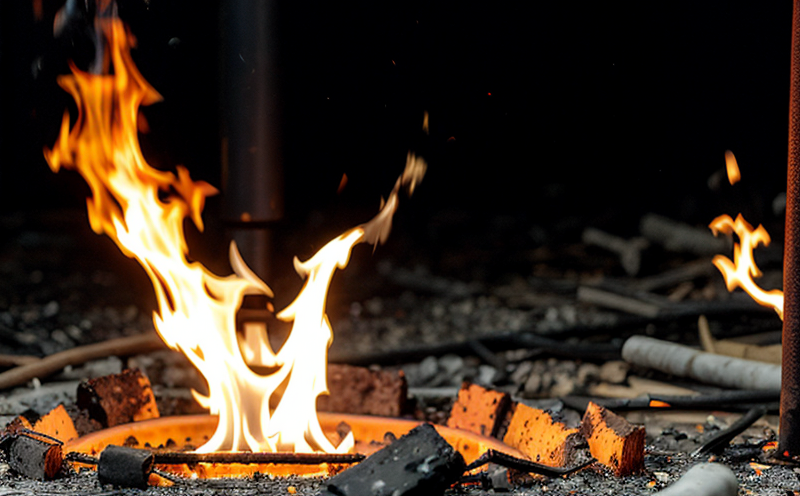ASTM F963 Flammability Resistance Evaluation
The ASTM F963-17a Standard Specification for Consumer Safety on Toy Standards is a comprehensive document that sets forth the requirements to ensure consumer safety and protect children from potential hazards. One of its critical components is flammability testing, which evaluates whether toys can ignite or continue burning under certain conditions. This service focuses specifically on ASTM F963-17a Section 20, which mandates tests for flame resistance in toy materials.
The importance of this test cannot be overstated, especially given the increasing trend towards creating smaller and more intricate toys that may be prone to catching fire under certain circumstances. Toys are often made from a variety of materials including plastics, fabrics, and foams, all of which can contribute to flammability risks if not properly evaluated.
The ASTM F963-17a specifies three primary test methods for flammability resistance: the open flame test, the heat source test, and the burntime test. Each method targets different aspects of a toy’s ability to resist ignition or continued burning when exposed to specific environmental factors.
The open flame test is conducted using an alcohol lamp with an adjustable wick height. The goal here is to simulate the potential for toys to ignite if they come into contact with an open flame source, such as from a lit candle or other household item. This test evaluates the toy’s resistance by measuring how long it takes for the material to ignite and continue burning.
The heat source test involves placing the toy under a heated plate to simulate exposure to high temperatures that might be encountered in environments like vehicles, especially during summer months when heat builds up inside cars or carriages. This test assesses the toy’s ability to withstand such conditions without catching fire or continuing to burn.
The burntime test measures the duration of burning for a specified area of the toy material after it has been ignited. This helps determine not only if the toy ignites but also how long it burns, which can indicate the overall risk of spreading fire in case of an accidental ignition.
Once the tests are completed, detailed reports are generated that document the test parameters, specimen preparation, instrumentation used, and results obtained. These reports serve as crucial tools for quality managers, compliance officers, R&D engineers, and procurement teams to ensure toys meet ASTM F963-17a standards and are safe for children.
Why It Matters
The safety of children is paramount in the toy industry. Toys that fail flammability tests can pose significant risks, leading to burn injuries or even fatalities if they ignite easily and continue burning. Ensuring compliance with ASTM F963-17a not only protects consumers but also helps manufacturers avoid legal issues and potential recalls.
- Prevents Burns: Toys that pass flammability tests are less likely to cause burns, especially in the hands of children who may play with them without proper supervision.
- Avoids Recalls: Compliance with ASTM F963-17a reduces the risk of product recalls and associated costs. Non-compliance can lead to significant financial losses due to legal actions, repairs, or replacements.
- Bolsters Brand Reputation: A strong reputation for producing safe toys enhances brand loyalty and trust with consumers. Companies that prioritize safety standards like ASTM F963-17a are more likely to gain consumer confidence.
Benefits
The benefits of adhering to ASTM F963-17a flammability testing standards extend beyond just meeting regulatory requirements. They also offer significant advantages in terms of product safety, reputation enhancement, and legal protection.
- Enhanced Product Safety: By ensuring that toys do not ignite or continue burning under specified conditions, manufacturers can significantly reduce the risk of accidents involving children.
- Improved Consumer Trust: Consumers are more likely to purchase and recommend products from brands they trust. Demonstrating commitment to safety standards like ASTM F963-17a fosters such trust.
- Avoidance of Legal Issues: Non-compliance with these standards can lead to legal challenges, fines, and reputational damage. Compliance helps avoid such issues entirely.
- Competitive Advantage: In a crowded market, compliance with international safety standards like ASTM F963-17a can set your products apart from competitors who do not prioritize safety.
Eurolab Advantages
EuroLab offers a comprehensive suite of services to help manufacturers comply with ASTM F963-17a. Our experienced team ensures that every aspect of the testing process is conducted rigorously and accurately, providing detailed reports and insights into areas where improvements can be made.
- Expertise: Our lab personnel are well-versed in ASTM F963-17a standards and have extensive experience conducting these tests.
- Accurate Instruments: We use state-of-the-art equipment to ensure precise measurements and reliable results.
- Rapid Turnaround: Our efficient processes allow for quick turnaround times, enabling manufacturers to receive test results promptly.
- Comprehensive Reporting: Detailed reports are provided that include all relevant data, ensuring transparency and clarity in the testing process.





